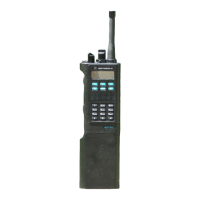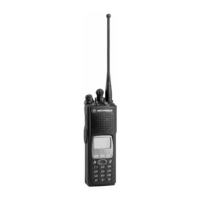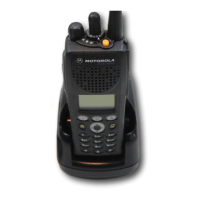28
When the radio is transmitting, microphone audio is passed from the audio
power amplifier (PA) to the DSP-support IC, where the signal is digitized. The
DSP-support IC passes digital data to the DSP, where pre-emphasis and low-
pass (splatter) filtering are done. The DSP returns this signal to the DSP-
support IC, where it is reconverted into an analog signal and scaled for
application to the voltage-controlled oscillator as a modulation signal.
Transmitted signalling information is accepted by the DSP from the
microcontrol unit, coded appropriately, and passed to the DSP-support IC,
which handles it the same as a voice signal. Modulation information is passed
to the synthesizer along the modulation line. A modulated carrier is provided
to the RF PA, which transmits the signal under dynamic power control.
ASTRO Mode
of Operation
In the ASTRO mode (digital mode) of operation, the transmitted or received
signal is limited to a discrete set of deviation levels, instead of continuously
varying. The receiver handles an ASTRO-mode signal identically to an analog-
mode signal up to the point where the DSP decodes the received data. In the
ASTRO receive mode, the DSP uses a specifically defined algorithm to recover
information.
In the ASTRO transmit mode, microphone audio is processed identically to an
analog mode with the exception of the algorithm the DSP uses to encode the
information. This algorithm will result in deviation levels that are limited to
discrete levels.
RF Board Basic
Theory of
Operation
The receiver front end consists of a preselector, an RF amplifier, a second
preselector, and a mixer. On the 800MHz receiver front end, both preselectors
are varactor-tuned, two-pole, fixed-tuned filters. The RF amplifier is a dual-
gate, gallium- arsenide based IC. The mixer is a double-balanced, active mixer
coupled by transformers. Injection is provided by the VCO through an
injection filter. See Table 13 for local oscillator (LO) and first IF information.
The frequency generation function is performed by three ICs and associated
circuitry. The reference oscillator provides a frequency standard to the
synthesizer/prescaler IC, which controls the VCO IC. The VCO IC actually
generates the first LO and transmit-injection signals and buffers them to the
required power level. The synthesizer/prescaler circuit module incorporates
frequency-division and comparison circuitry to keep the VCO signals stable.
The synthesizer/prescaler IC is controlled by the microcontrol unit through a
serial bus. Most of the synthesizer circuitry is enclosed in rigid metal cans on
the RF board to reduce microphonic effects.
The receiver back end consists of a two-pole crystal filter, an IF amplifier, a
second two-pole crystal filter, and the digital back-end IC. The two-pole filters
are wide enough to accommodate 5kHz modulation. Final IF filtering is done
digitally in the DSP-support IC.
Table 13 Local Oscillator and First IF Frequencies
800MHz
LO Frequency Range 732.65-796.65MHz
First IF Frequency 73.35MHz

